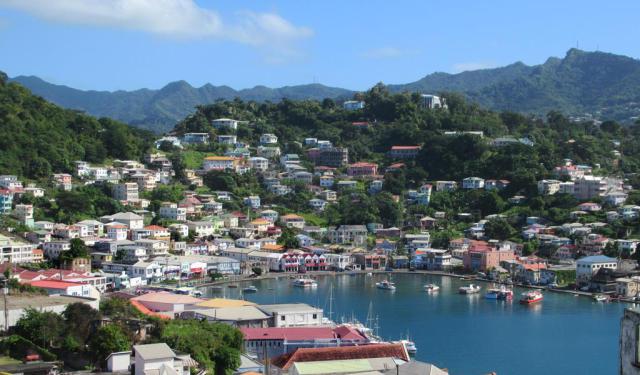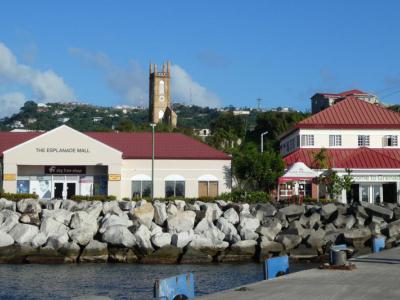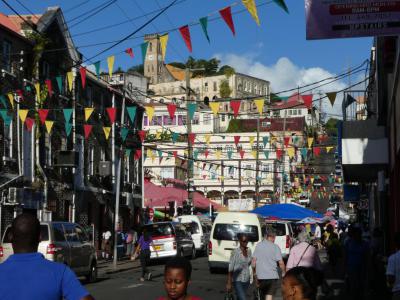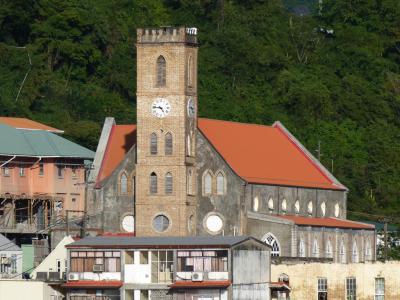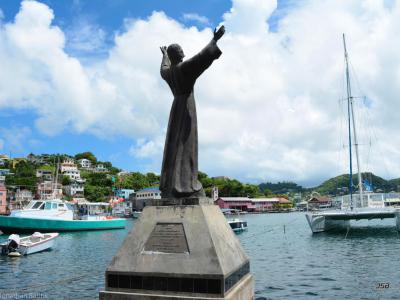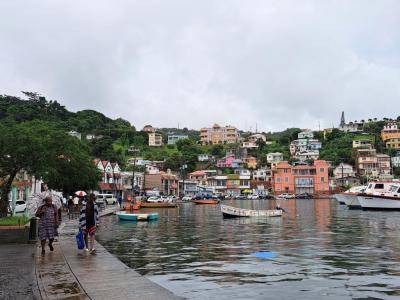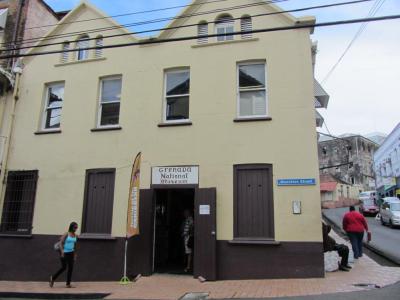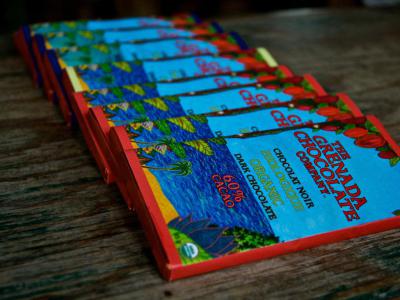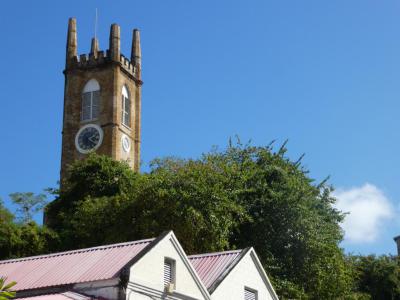Audio Guide: St. Georges Introduction Walking Tour (Self Guided), St. Georges
Few Caribbean cities blend history and beauty as effortlessly as St. George’s. Cradled between emerald hills and a perfect horseshoe harbour, it has long been both Grenada’s heart and its mirror.
The French were the first Europeans to establish a permanent settlement here in 1650, founding a modest community called “Fort Royal Town”. Its position — protected by steep hills and overlooking a deep anchorage — was ideal for defense and trade. Under French rule, the settlement grew into a fortified outpost, its prominence tied to the island’s lucrative sugar and spice industries.
During the Seven Years’ War, the British captured Grenada in 1762, and the following year's Treaty of Paris formalized their control. They renamed both the town and its fortress after their monarch and patron saint — Fort George and St. George’s — marking the start of a new colonial era. The harbor’s depth and central position soon made it one of the Caribbean’s busiest ports. Ships carried out sugar, cocoa, and nutmeg, the last of which earned Grenada its lasting nickname: “Island of Spice.” The arrival of enslaved Africans in the late eighteenth century fueled plantation wealth, embedding both economic prosperity and human suffering into the city’s past.
The town’s architecture bears the imprint of both empires: French red-tiled roofs, Georgian stone buildings, and narrow, winding streets that climb steeply from the waterfront. Landmarks such as Fort George and Fort Frederick still overlook the bay, reminders of the battles once fought for dominance in the region.
In later centuries, St. George’s became a key administrative center within the British Windward Islands colony, serving briefly as its capital in the 1880s. It remained under British rule until Grenada gained independence in 1974. The twentieth century also brought trials — economic challenges, political unrest, and natural disasters like the 2004 Hurricane Ivan — but the city continually rebuilt and modernized.
Walking through St. George’s downtown, you’ll wander by the curved harbour lined with colourful colonial warehouses, climb past the stone ramparts of Fort George for sweeping sea views, and duck into Market Square where spice-laden stalls hum with local life. The mellow sound of steel drums drifts from cafés tucked between pastel houses, while the salty harbour breeze mingles with the scent of nutmeg and cocoa — a vivid slice of Grenada.
As you finish your walk, glance once more at the harbour below — the same curve of water that first drew settlers nearly four centuries ago. St. George’s remains what it has always been: the beating heart of Grenada.
The French were the first Europeans to establish a permanent settlement here in 1650, founding a modest community called “Fort Royal Town”. Its position — protected by steep hills and overlooking a deep anchorage — was ideal for defense and trade. Under French rule, the settlement grew into a fortified outpost, its prominence tied to the island’s lucrative sugar and spice industries.
During the Seven Years’ War, the British captured Grenada in 1762, and the following year's Treaty of Paris formalized their control. They renamed both the town and its fortress after their monarch and patron saint — Fort George and St. George’s — marking the start of a new colonial era. The harbor’s depth and central position soon made it one of the Caribbean’s busiest ports. Ships carried out sugar, cocoa, and nutmeg, the last of which earned Grenada its lasting nickname: “Island of Spice.” The arrival of enslaved Africans in the late eighteenth century fueled plantation wealth, embedding both economic prosperity and human suffering into the city’s past.
The town’s architecture bears the imprint of both empires: French red-tiled roofs, Georgian stone buildings, and narrow, winding streets that climb steeply from the waterfront. Landmarks such as Fort George and Fort Frederick still overlook the bay, reminders of the battles once fought for dominance in the region.
In later centuries, St. George’s became a key administrative center within the British Windward Islands colony, serving briefly as its capital in the 1880s. It remained under British rule until Grenada gained independence in 1974. The twentieth century also brought trials — economic challenges, political unrest, and natural disasters like the 2004 Hurricane Ivan — but the city continually rebuilt and modernized.
Walking through St. George’s downtown, you’ll wander by the curved harbour lined with colourful colonial warehouses, climb past the stone ramparts of Fort George for sweeping sea views, and duck into Market Square where spice-laden stalls hum with local life. The mellow sound of steel drums drifts from cafés tucked between pastel houses, while the salty harbour breeze mingles with the scent of nutmeg and cocoa — a vivid slice of Grenada.
As you finish your walk, glance once more at the harbour below — the same curve of water that first drew settlers nearly four centuries ago. St. George’s remains what it has always been: the beating heart of Grenada.
How it works: Download the app "GPSmyCity: Walks in 1K+ Cities" from Apple App Store or Google Play Store to your mobile phone or tablet. The app turns your mobile device into a personal tour guide and its built-in GPS navigation functions guide you from one tour stop to next. The app works offline, so no data plan is needed when traveling abroad.
St. Georges Introduction Walking Tour Map
Guide Name: St. Georges Introduction Walking Tour
Guide Location: Grenada » St. Georges (See other walking tours in St. Georges)
Guide Type: Self-guided Walking Tour (Sightseeing)
# of Attractions: 10
Tour Duration: 1 Hour(s)
Travel Distance: 1.7 Km or 1.1 Miles
Author: DanaOffice
Sight(s) Featured in This Guide:
Guide Location: Grenada » St. Georges (See other walking tours in St. Georges)
Guide Type: Self-guided Walking Tour (Sightseeing)
# of Attractions: 10
Tour Duration: 1 Hour(s)
Travel Distance: 1.7 Km or 1.1 Miles
Author: DanaOffice
Sight(s) Featured in This Guide:
- Cruise Ship Terminal
- Market Square
- Immaculate Conception Cathedral
- York House
- Christ the Deep
- The Carenage
- Grenada National Museum
- House of Chocolate
- St. Andrew's Presbyterian Church
- Fort George
1) Cruise Ship Terminal
The Cruise Ship Terminal in St. George’s offers visitors a relaxed and less crowded introduction to the Southern and Eastern Caribbean. Set in the capital of this compact and scenic island, the port provides an easy and welcoming entry point for cruise passengers looking to experience Grenada at their own pace.
Located at the end of the newer Melville Street Pier, the terminal is designed with traveler comfort in mind. Inside, you’ll find practical amenities such as restrooms, ATMs, and free Wi-Fi. The Grenada Tourism Authority runs an information kiosk that supplies maps, brochures, and helpful tips for exploring the island.
For those planning to explore independently, several convenient services are available just outside the terminal. Stalls offer tickets for water taxis, a small sightseeing train tour of St. George’s, and transportation through the official taxi dispatch desk. This system helps ensure clear pricing and dependable service.
The terminal also connects directly to the Esplanade Shopping Mall, where visitors can browse a wide mix of stores. Many shops sell locally made souvenirs and crafts, while others feature duty-free items from brands such as Colombian Emeralds and Milano, giving shoppers a range of options.
Stepping out of the terminal building brings you straight into historic downtown St. George’s. Its narrow streets and colorful buildings create a pleasant setting for a short walk, with several attractions close by. The sightseeing train, located just a short distance from the exit, offers an easy way to get an overview of the town and learn about its character and history.
Located at the end of the newer Melville Street Pier, the terminal is designed with traveler comfort in mind. Inside, you’ll find practical amenities such as restrooms, ATMs, and free Wi-Fi. The Grenada Tourism Authority runs an information kiosk that supplies maps, brochures, and helpful tips for exploring the island.
For those planning to explore independently, several convenient services are available just outside the terminal. Stalls offer tickets for water taxis, a small sightseeing train tour of St. George’s, and transportation through the official taxi dispatch desk. This system helps ensure clear pricing and dependable service.
The terminal also connects directly to the Esplanade Shopping Mall, where visitors can browse a wide mix of stores. Many shops sell locally made souvenirs and crafts, while others feature duty-free items from brands such as Colombian Emeralds and Milano, giving shoppers a range of options.
Stepping out of the terminal building brings you straight into historic downtown St. George’s. Its narrow streets and colorful buildings create a pleasant setting for a short walk, with several attractions close by. The sightseeing train, located just a short distance from the exit, offers an easy way to get an overview of the town and learn about its character and history.
2) Market Square
The Market Square stands as a premier attraction within the capital city, offering visitors an immersive experience into the local culture and traditions. Situated at the heart of St. George's, this vibrant square exudes charm with its picturesque colonial architecture and bustling ambiance.
At the core of Market Square is the bustling market itself, which stands as the largest in Grenada and serves as a focal point for both locals and tourists alike. The market is a treasure trove of sensory delights, with stalls brimming with fresh island produce, including an array of fruits, vegetables, and fragrant spices. Visitors can wander through the lively stalls, taking in the vibrant colors and aromas while immersing themselves in the authentic atmosphere of Grenada.
Beyond the market stalls, Market Square is a hub of activity where people gather to shop, eat, and socialize. On any given day, the square is alive with energy as locals and visitors mingle amidst the vibrant surroundings. Fridays and Saturdays, in particular, see Market Square at its busiest, with the air filled with the sounds of commerce and camaraderie.
For those seeking a taste of Grenada's rich cultural heritage, Market Square offers a wealth of experiences. Live entertainment, music, and dance performances often grace the square, further enhancing its lively atmosphere and providing visitors with a glimpse into the island's vibrant traditions.
At the core of Market Square is the bustling market itself, which stands as the largest in Grenada and serves as a focal point for both locals and tourists alike. The market is a treasure trove of sensory delights, with stalls brimming with fresh island produce, including an array of fruits, vegetables, and fragrant spices. Visitors can wander through the lively stalls, taking in the vibrant colors and aromas while immersing themselves in the authentic atmosphere of Grenada.
Beyond the market stalls, Market Square is a hub of activity where people gather to shop, eat, and socialize. On any given day, the square is alive with energy as locals and visitors mingle amidst the vibrant surroundings. Fridays and Saturdays, in particular, see Market Square at its busiest, with the air filled with the sounds of commerce and camaraderie.
For those seeking a taste of Grenada's rich cultural heritage, Market Square offers a wealth of experiences. Live entertainment, music, and dance performances often grace the square, further enhancing its lively atmosphere and providing visitors with a glimpse into the island's vibrant traditions.
3) Immaculate Conception Cathedral
Perched atop a hill overlooking the harbor, the Immaculate Conception Cathedral commands attention with its imposing presence and stunning views of the surrounding area. While the current cathedral was completed in 1884, its history traces back to a small chapel dedicated to Saint James, which stood on the site since 1804. The Gothic-style tower, a notable feature of the cathedral, dates back to 1818, adding to its architectural charm and historical significance.
Despite its simplicity compared to European Catholic cathedrals, the Immaculate Conception Cathedral exudes a sense of grandeur and reverence. Inside, visitors will find a tranquil space adorned with understated decorations, reflecting the humility and devotion of its worshippers.
However, the cathedral's resilience is perhaps its most remarkable attribute. Following the devastation caused by Hurricane Ivan in 2004, which inflicted severe damage upon the structure, the cathedral underwent extensive restoration efforts. Despite the challenges posed by the natural disaster, the cathedral has been meticulously restored to its former glory, a testament to the dedication and perseverance of the community.
Beyond its religious significance, the cathedral also offers visitors a unique vantage point from which to admire the beauty of Saint George's. Sitting atop the capital's hill, it provides panoramic views of the town and its picturesque surroundings, inviting contemplation and reflection.
Despite its simplicity compared to European Catholic cathedrals, the Immaculate Conception Cathedral exudes a sense of grandeur and reverence. Inside, visitors will find a tranquil space adorned with understated decorations, reflecting the humility and devotion of its worshippers.
However, the cathedral's resilience is perhaps its most remarkable attribute. Following the devastation caused by Hurricane Ivan in 2004, which inflicted severe damage upon the structure, the cathedral underwent extensive restoration efforts. Despite the challenges posed by the natural disaster, the cathedral has been meticulously restored to its former glory, a testament to the dedication and perseverance of the community.
Beyond its religious significance, the cathedral also offers visitors a unique vantage point from which to admire the beauty of Saint George's. Sitting atop the capital's hill, it provides panoramic views of the town and its picturesque surroundings, inviting contemplation and reflection.
4) York House
York House, also called Parliament House, once held a central place in the history and architecture of St. George’s. Before its destruction by Hurricane Ivan in 2004, the building served as the seat of Grenada’s Parliament for more than a century, acting as both a political hub and an important landmark in the capital.
Built in the 1770s, the structure originally served as the home of the Depontieu family. Its size and style brought a sense of prominence to the area. In 1801, the government purchased the property and converted it into the meeting place for the colonial legislature. It was later named after the Duke of York, whose visit to Grenada in the 18th century reinforced its status as a major public building.
After Grenada gained independence in 1974, York House became the official home of the nation’s Parliament. Legislative sessions, debates, and state functions were held within its walls. The Supreme Court also occupied the lower floor, making the building essential to both the legislative and judicial systems.
York House was the setting for several notable occasions, including a visit by Queen Elizabeth II in 1985, during which she attended a special session of Parliament. Events like this highlighted the building’s role in national life.
Hurricane Ivan dealt a severe blow to York House in 2004, leaving the structure badly damaged and unsafe to use. Since then, it has remained abandoned, standing as a reminder of its long service to Grenada’s political and civic history.
York House bore witness to numerous significant events throughout its existence, including a visit by Queen Elizabeth II in 1985, during which she presided over a special session of Parliament. This royal visit underscored the building's status as a cornerstone of Grenada's political and cultural heritage.
Tragically, York House fell victim to the destructive forces of Hurricane Ivan in 2004, sustaining irreparable damage that rendered it uninhabitable. Following the storm, the building was abandoned, leaving behind memories of its former glory and a void in Grenada's architectural landscape.
Built in the 1770s, the structure originally served as the home of the Depontieu family. Its size and style brought a sense of prominence to the area. In 1801, the government purchased the property and converted it into the meeting place for the colonial legislature. It was later named after the Duke of York, whose visit to Grenada in the 18th century reinforced its status as a major public building.
After Grenada gained independence in 1974, York House became the official home of the nation’s Parliament. Legislative sessions, debates, and state functions were held within its walls. The Supreme Court also occupied the lower floor, making the building essential to both the legislative and judicial systems.
York House was the setting for several notable occasions, including a visit by Queen Elizabeth II in 1985, during which she attended a special session of Parliament. Events like this highlighted the building’s role in national life.
Hurricane Ivan dealt a severe blow to York House in 2004, leaving the structure badly damaged and unsafe to use. Since then, it has remained abandoned, standing as a reminder of its long service to Grenada’s political and civic history.
York House bore witness to numerous significant events throughout its existence, including a visit by Queen Elizabeth II in 1985, during which she presided over a special session of Parliament. This royal visit underscored the building's status as a cornerstone of Grenada's political and cultural heritage.
Tragically, York House fell victim to the destructive forces of Hurricane Ivan in 2004, sustaining irreparable damage that rendered it uninhabitable. Following the storm, the building was abandoned, leaving behind memories of its former glory and a void in Grenada's architectural landscape.
5) Christ the Deep
Christ the Deep, a poignant statue situated at the Carenage harbor, stands as a testament to the heroic efforts and resilience of the Grenadian people in the face of tragedy. The statue commemorates the fate of the Bianca C, an Italian luxury cruise ship often likened to the "Titanic of the Caribbean," which met a tragic end in Grenadian waters in 1961.
In the early morning hours of October 22, 1961, tragedy struck as a major explosion rocked the boiler room of the Bianca C while it was anchored at St. George's harbor. In the wake of the explosion, chaos ensued as nearly 700 passengers and crew found themselves in peril. However, in an extraordinary display of courage and compassion, local residents swiftly mobilized to rescue those aboard the stricken vessel.
Grenadian fishermen bravely manned their boats, risking their lives to pluck survivors from the water and bring them to safety. The community rallied together, setting up a makeshift hospital to tend to the injured and welcoming survivors into their homes with open arms. Despite the chaos and uncertainty, the people of Grenada demonstrated extraordinary humanity and selflessness in the face of adversity.
Tragically, the Bianca C ultimately succumbed to its fate, sinking near Grand Anse Beach two days after the initial explosion. However, the legacy of the disaster lives on in the gratitude and admiration of the survivors and their families.
In recognition of the heroic efforts of the Grenadian people, Costa Line, the owners of the Bianca C, gifted the statue known as Christ the Deep to the island. Crafted from bronze, the statue is a replica of the Christ of the Abyss, a renowned sculpture located underwater in the Mediterranean Sea near Genoa, Italy. The original sculpture was created by artist Guido Galletti.
In the early morning hours of October 22, 1961, tragedy struck as a major explosion rocked the boiler room of the Bianca C while it was anchored at St. George's harbor. In the wake of the explosion, chaos ensued as nearly 700 passengers and crew found themselves in peril. However, in an extraordinary display of courage and compassion, local residents swiftly mobilized to rescue those aboard the stricken vessel.
Grenadian fishermen bravely manned their boats, risking their lives to pluck survivors from the water and bring them to safety. The community rallied together, setting up a makeshift hospital to tend to the injured and welcoming survivors into their homes with open arms. Despite the chaos and uncertainty, the people of Grenada demonstrated extraordinary humanity and selflessness in the face of adversity.
Tragically, the Bianca C ultimately succumbed to its fate, sinking near Grand Anse Beach two days after the initial explosion. However, the legacy of the disaster lives on in the gratitude and admiration of the survivors and their families.
In recognition of the heroic efforts of the Grenadian people, Costa Line, the owners of the Bianca C, gifted the statue known as Christ the Deep to the island. Crafted from bronze, the statue is a replica of the Christ of the Abyss, a renowned sculpture located underwater in the Mediterranean Sea near Genoa, Italy. The original sculpture was created by artist Guido Galletti.
6) The Carenage (must see)
The Carenage, an enchanting horseshoe-shaped inner harbor and anchorage, stands as the vibrant heart of St. George's, offering visitors a captivating glimpse into the daily rhythms of life in this bustling Caribbean city. With its picturesque waterfront, colorful wooden schooners, and charming colonial-era buildings, The Carenage is a lively hub of activity where history and culture converge.
For over 300 years, The Carenage has provided a safe haven for sailors and their vessels, serving as a vital lifeline for trade and commerce in the region. Today, it remains a bustling maritime center, where boats of all shapes and sizes from around the world bob gently in the tranquil waters alongside charming colonial-era buildings.
Wandering along the waterfront promenade of The Carenage, visitors are treated to a sensory feast of sights, sounds, and aromas. Fishermen can be seen unloading their fresh catch from colorful wooden schooners, while locals haggle for the choicest seafood at the bustling fish market. Container ships unload supplies, adding to the lively atmosphere of this bustling maritime hub.
Aside from its maritime activities, The Carenage also offers a wealth of dining, shopping, and entertainment options. Visitors can browse the shops that line the waterfront, discovering local crafts, souvenirs, and treasures. Meanwhile, restaurants and cafes beckon with the tantalizing aromas of fresh seafood and snacks, offering the perfect opportunity to relax and savor the flavors of Grenadian cuisine.
Wharf Road, which runs along the harbor, provides excellent vantage points for soaking in the panoramic views of The Carenage and its surroundings. From here, visitors can watch the comings and goings of boats, soak in the ambiance of the bustling waterfront, and admire the charming colonial architecture that lines the seafront promenade.
For over 300 years, The Carenage has provided a safe haven for sailors and their vessels, serving as a vital lifeline for trade and commerce in the region. Today, it remains a bustling maritime center, where boats of all shapes and sizes from around the world bob gently in the tranquil waters alongside charming colonial-era buildings.
Wandering along the waterfront promenade of The Carenage, visitors are treated to a sensory feast of sights, sounds, and aromas. Fishermen can be seen unloading their fresh catch from colorful wooden schooners, while locals haggle for the choicest seafood at the bustling fish market. Container ships unload supplies, adding to the lively atmosphere of this bustling maritime hub.
Aside from its maritime activities, The Carenage also offers a wealth of dining, shopping, and entertainment options. Visitors can browse the shops that line the waterfront, discovering local crafts, souvenirs, and treasures. Meanwhile, restaurants and cafes beckon with the tantalizing aromas of fresh seafood and snacks, offering the perfect opportunity to relax and savor the flavors of Grenadian cuisine.
Wharf Road, which runs along the harbor, provides excellent vantage points for soaking in the panoramic views of The Carenage and its surroundings. From here, visitors can watch the comings and goings of boats, soak in the ambiance of the bustling waterfront, and admire the charming colonial architecture that lines the seafront promenade.
7) Grenada National Museum
Opened in 1976, the Grenada National Museum occupies a building with a storied past, having served as French barracks, a prison, hotels, and a warehouse before being transformed into a beacon of cultural preservation. Stepping inside the Grenada National Museum, visitors are greeted with a treasure trove of historical artifacts and exhibits that span the island's rich and diverse heritage. From the earliest inhabitants to the colonial era, slavery, plantation economy, and beyond, the museum offers immersive displays that shed light on pivotal moments and chapters in Grenada's history.
Among the museum's highlights are artifacts and collections that depict key political and social events, such as Grenada's journey to independence, the Grenada Revolution, and the assassination of Prime Minister Maurice Bishop. One notable piece is a marble bathtub believed to have been used by Empress Josephine Bonaparte during her childhood, adding a touch of international intrigue to the museum's offerings.
In addition to its focus on historical events and figures, the Grenada National Museum celebrates the island's vibrant cultural heritage. Visitors can explore exhibits showcasing Grenadian festivals, traditions, and ways of life, gaining insight into the rich tapestry of indigenous culture that shapes the island's identity.
Beyond its exhibits, the museum offers a variety of activities and amenities for visitors to enjoy. Live cultural performances, including jazz, dancing, drumming, singing, and poetry, provide immersive experiences that bring Grenada's vibrant culture to life. Additionally, the museum boasts an outdoor café and bistro where visitors can savor a meal in the historical setting of the museum grounds.
Among the museum's highlights are artifacts and collections that depict key political and social events, such as Grenada's journey to independence, the Grenada Revolution, and the assassination of Prime Minister Maurice Bishop. One notable piece is a marble bathtub believed to have been used by Empress Josephine Bonaparte during her childhood, adding a touch of international intrigue to the museum's offerings.
In addition to its focus on historical events and figures, the Grenada National Museum celebrates the island's vibrant cultural heritage. Visitors can explore exhibits showcasing Grenadian festivals, traditions, and ways of life, gaining insight into the rich tapestry of indigenous culture that shapes the island's identity.
Beyond its exhibits, the museum offers a variety of activities and amenities for visitors to enjoy. Live cultural performances, including jazz, dancing, drumming, singing, and poetry, provide immersive experiences that bring Grenada's vibrant culture to life. Additionally, the museum boasts an outdoor café and bistro where visitors can savor a meal in the historical setting of the museum grounds.
8) House of Chocolate (must see)
The House of Chocolate Grenada Museum stands as a delightful and informative attraction, celebrating Grenada's vibrant cocoa production and chocolate-making culture. Nestled in the heart of St. George's, this charming museum offers visitors a captivating journey through the history, artistry, and flavors of chocolate.
At the House of Chocolate, guests are invited to immerse themselves in the fascinating world of cocoa production and chocolate crafting. Through a series of interactive exhibits, audio-visual presentations, and live demonstrations, visitors gain insight into every stage of the chocolate-making process, from the cultivation of cocoa trees to the creation of delectable chocolate treats. Learn about the traditional methods used by Grenadian farmers to harvest cocoa beans and discover the secrets behind crafting exquisite chocolate bars.
The museum not only educates but also indulges the senses, allowing visitors to sample a variety of decadent chocolate creations freshly made on-site. From rich and velvety chocolate bars to creamy truffles and artisanal bonbons, there's something to satisfy every sweet tooth.
In addition to its educational exhibits, the House of Chocolate features a cozy café where visitors can savor delicious chocolate treats while basking in the museum's inviting ambiance. Whether enjoying a cup of rich hot chocolate or indulging in a slice of chocolate cake, guests can delight in the flavors of Grenada's finest cocoa creations.
For those looking to take a piece of Grenada's chocolate culture home with them, the museum's boutique offers a curated selection of cocoa-inspired products, including handcrafted chocolates, cocoa-infused skincare products, and artisanal souvenirs. From gourmet chocolate bars to cocoa-scented candles, the boutique is a treasure trove of delights for chocolate enthusiasts and connoisseurs alike.
At the House of Chocolate, guests are invited to immerse themselves in the fascinating world of cocoa production and chocolate crafting. Through a series of interactive exhibits, audio-visual presentations, and live demonstrations, visitors gain insight into every stage of the chocolate-making process, from the cultivation of cocoa trees to the creation of delectable chocolate treats. Learn about the traditional methods used by Grenadian farmers to harvest cocoa beans and discover the secrets behind crafting exquisite chocolate bars.
The museum not only educates but also indulges the senses, allowing visitors to sample a variety of decadent chocolate creations freshly made on-site. From rich and velvety chocolate bars to creamy truffles and artisanal bonbons, there's something to satisfy every sweet tooth.
In addition to its educational exhibits, the House of Chocolate features a cozy café where visitors can savor delicious chocolate treats while basking in the museum's inviting ambiance. Whether enjoying a cup of rich hot chocolate or indulging in a slice of chocolate cake, guests can delight in the flavors of Grenada's finest cocoa creations.
For those looking to take a piece of Grenada's chocolate culture home with them, the museum's boutique offers a curated selection of cocoa-inspired products, including handcrafted chocolates, cocoa-infused skincare products, and artisanal souvenirs. From gourmet chocolate bars to cocoa-scented candles, the boutique is a treasure trove of delights for chocolate enthusiasts and connoisseurs alike.
9) St. Andrew's Presbyterian Church
Saint Andrew’s Presbyterian Church is closely tied to Grenada’s early Scottish community and reflects an important chapter in the island’s cultural history. Founded in 1830, the church was established to serve the growing Presbyterian population that settled on the island during the 19th century. Construction finished in 1833, giving Saint George’s a new landmark overlooking the Inner Harbour.
One of the church’s most recognizable features is its tall clock tower. Fitted with a bell cast in Glasgow, the tower represents the lasting connection between Grenada and Scotland. For generations, it served as a familiar point of reference for residents and sailors approaching the harbor, marking both time and place within the busy town.
On September 7, 2004, Hurricane Ivan caused severe damage to Saint Andrew’s Kirk. The storm left the building in a fragile state, and full restoration has yet to be completed. The church now stands as a quiet reminder of the hurricane’s impact and the community’s ongoing efforts to preserve its heritage.
Even in its current condition, the church remains a meaningful presence in Saint George’s. Visitors can still see the clock tower rising above the hillside near the cruise terminal. From this point, a nearby staircase leads upward toward a path connecting to Fort George. The walk provides wide views of the harbor and surrounding landscape, giving travelers a sense of how the church once served both practical and spiritual roles in daily life.
One of the church’s most recognizable features is its tall clock tower. Fitted with a bell cast in Glasgow, the tower represents the lasting connection between Grenada and Scotland. For generations, it served as a familiar point of reference for residents and sailors approaching the harbor, marking both time and place within the busy town.
On September 7, 2004, Hurricane Ivan caused severe damage to Saint Andrew’s Kirk. The storm left the building in a fragile state, and full restoration has yet to be completed. The church now stands as a quiet reminder of the hurricane’s impact and the community’s ongoing efforts to preserve its heritage.
Even in its current condition, the church remains a meaningful presence in Saint George’s. Visitors can still see the clock tower rising above the hillside near the cruise terminal. From this point, a nearby staircase leads upward toward a path connecting to Fort George. The walk provides wide views of the harbor and surrounding landscape, giving travelers a sense of how the church once served both practical and spiritual roles in daily life.
10) Fort George (must see)
Built between 1706 and 1710, Fort George is widely regarded as the most important historic site in St. George’s. Its long history is closely tied to many defining events on the island, including the conclusion of the Grenada Revolution on October 19, 1983. Today, the fort remains active as the headquarters of the Royal Grenada Police Force, keeping it firmly connected to daily life in the capital.
The fort was originally named Fort Royal, but its name changed to Fort George in 1763 in honor of King George III after the British took control of Grenada. Designed as a bastion-style fort, it features layered defensive levels that supported one another in times of conflict. Visitors can still see many elements typical of European military engineering of that era, including the parade ground, barracks, guardroom, gunpowder magazine, water cistern, sally port, cannons, and covered passages used for firing positions.
Fort George is also known for the wide views it provides of the surrounding landscape. From the upper levels, visitors can look out across St. George’s Town, the harbor, the southern coastline, and the open sea. The presence of historic cannons throughout the site offers appealing backdrops for photographs and helps illustrate the fort’s original defensive purpose.
Reaching the fort is relatively easy. Visitors can walk up the stairs next to the exit of the Sendall Tunnel or follow the main road leading toward the General Hospital. Exploring Fort George offers a thoughtful introduction to Grenada’s past, combining military architecture, key historical events, and far-reaching views of the island’s capital.
The fort was originally named Fort Royal, but its name changed to Fort George in 1763 in honor of King George III after the British took control of Grenada. Designed as a bastion-style fort, it features layered defensive levels that supported one another in times of conflict. Visitors can still see many elements typical of European military engineering of that era, including the parade ground, barracks, guardroom, gunpowder magazine, water cistern, sally port, cannons, and covered passages used for firing positions.
Fort George is also known for the wide views it provides of the surrounding landscape. From the upper levels, visitors can look out across St. George’s Town, the harbor, the southern coastline, and the open sea. The presence of historic cannons throughout the site offers appealing backdrops for photographs and helps illustrate the fort’s original defensive purpose.
Reaching the fort is relatively easy. Visitors can walk up the stairs next to the exit of the Sendall Tunnel or follow the main road leading toward the General Hospital. Exploring Fort George offers a thoughtful introduction to Grenada’s past, combining military architecture, key historical events, and far-reaching views of the island’s capital.
The Most Popular Cities
/ view all
